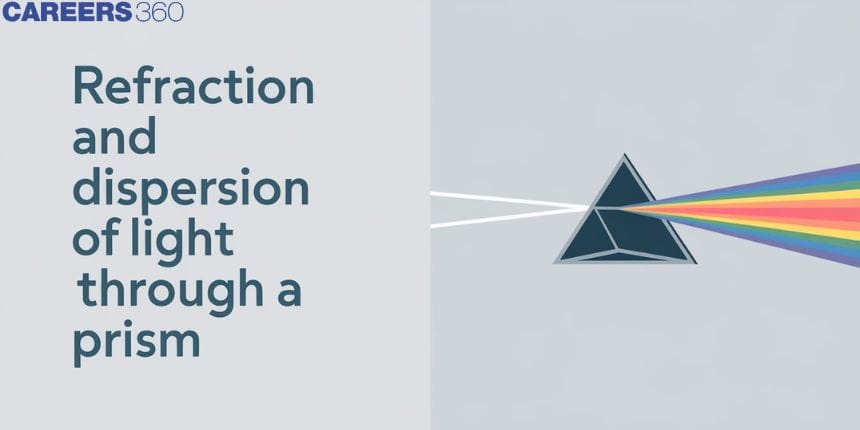Refraction and Dispersion of Light through a Prism
Rainbows are beautiful examples of a physical phenomenon termed the dispersion of light. It occurs when white light splits into seven colors-violet, indigo, blue, green, yellow, orange, and red-while passing through a prism. A prism is a transparent optical element with flat, polished surfaces that refract light. Refraction means the bending of light as it travels from one medium to another, like air to glass or water. Each color of light, based on its wavelength, bends by a different amount, so the colors spread out.
Learners will understand the concept of dispersion, how prisms work, and the main cause of dispersion in this article.
This Story also Contains
- What is Prism in physics?
- What Is Dispersion of Light?
- Refraction Of Light Through Prism
- Relation between Refraction and Dispersion:
- Visible Light Spectrum
- Causes of Dispersion of Light

Also read -
What is Prism in physics?
A prism is an object made up of a transparent material, like glass or plastic that has at least two flat surfaces that form an acute angle.

What Is Dispersion of Light?
Dispersion of light is the phenomenon in which white light splits into its seven component colors, violet, indigo, blue, green, yellow, orange, and red, when it passes through a prism or any transparent medium.

Refraction Of Light Through Prism
Refraction of light through a prism is the process in which a ray of light bends twice while passing through a prism — once when it enters and once when it leaves the prism.
When a light ray enters from air (rarer medium) into the glass prism (denser medium), it bends towards the normal. On emerging from the prism into air again, it bends away from the normal.
Due to these two refractions, the direction of the light changes, and the emerging ray is not parallel to the incident ray. The angle between them is called the angle of deviation.
Relation between Refraction and Dispersion:
Any bending of waves caused by a change in speed is referred to as refraction. A wave is said to be refracted when it travels through different depths. The frequency dependence of refraction is referred to as dispersion. When light is refracted by a prism, dispersion refers to how much the higher frequency light bends.
Visible Light Spectrum
The visible light spectrum is the range of colors of light that the human eye can see. It is a small part of the electromagnetic spectrum, lying between infrared and ultraviolet light.
When white light passes through a prism, it splits into seven colors Violet, Indigo, Blue, Green, Yellow, Orange, and Red (VIBGYOR). This happens because each color has a different wavelength and bends by a different amount during refraction.
- Violet has the shortest wavelength (about 400 nm).
- Red has the longest wavelength (about 700 nm).
Causes of Dispersion of Light
- Different Wavelengths: Each color of light has a different wavelength. Shorter wavelengths (like violet) bend more than longer wavelengths (like red).
- Change in Refractive Index: The refractive index of a medium (like glass) is different for different colors of light. This difference causes each color to deviate by a different angle.
- Refraction at Two Surfaces: Light is refracted twice in a prism - once when it enters and once when it leaves. This double bending enhances the separation of colors.
Also Read:
- NCERT solutions for Class 12 Physics Chapter 9 Ray Optics and Optical Instruments
- NCERT Exemplar Class 12 Physics Solutions Chapter 9 Ray Optics and Optical Instruments
- NCERT notes Class 12 Physics Chapter 9 Ray Optics and Optical Instruments
Also check-
- NCERT Exemplar Class 11th Physics Solutions
- NCERT Exemplar Class 12th Physics Solutions
- NCERT Exemplar Solutions for All Subjects
NCERT Physics Notes:
Frequently Asked Questions (FAQs)
Dispersion due to a prism happens because each color of light has a different wavelength and the prism’s refractive index varies for each wavelength. Hence, violet bends the most and red bends the least, creating a spectrum
Refraction is the bending of light when it passes from one medium to another (like air to glass). Dispersion is the splitting of white light into its seven colors due to different bending (refraction) of each color.
When a ray of light travels obliquely from one clear medium to another, it deviates from its original course. Refraction is the term for the deviation of a light ray. The variation in the velocity of light in the different mediums causes refraction. In a rarer media, light travels faster, while in a denser medium, it travels slower.
The phenomenon of dispersion happens when a wave's phase velocity varies with its frequency. Dispersion media are media that have this attribute in common. Dispersion results in a loss of kinetic energy due to absorption on a physical level.
The bending of light as it moves from one medium to another is known as refraction. For example, when a ray of light passes through a glass prism, refraction happens both when it enters and exits the prism.
Any bending of waves caused by a change in speed is referred to as refraction. The production of refraction occurs when water waves travel over a range of depths and heights.
When we state that light is refracted by a prism, we are referring to dispersion, which means that there will be a higher frequency of light bending.
The bending of light is referred to as refraction, while the frequency dependence of light properties is referred to as dispersion.
When light passes through a prism, it bends twice once while entering and once while leaving the prism. This bending is called refraction. Because each color of light bends by a different amount, white light splits into seven colors (VIBGYOR). This splitting is called dispersion of light.